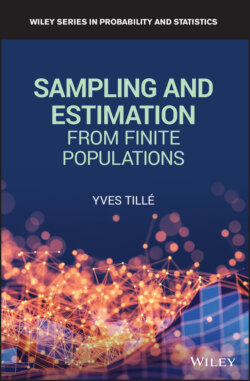Читать книгу Sampling and Estimation from Finite Populations - Yves Tille - Страница 54
Exercises
Оглавление1 2.1 Show that
2 2.2 Let be a population with the following sampling design:Give the first‐order inclusion probabilities. Give the variance–covariance matrix of the indicator variables.
3 2.3 Let and have the following sampling design:Give the probability distributions of the expansion estimator and the Hájek estimator of the mean. Give the probability distributions of the two variance estimators of the expansion estimator and calculate their bias.Give the probability distributions of the two variance estimators of the expansion estimator of the mean in the case where .
4 2.4 Let be a sampling design without replacement applied to a population of size . Let and denote the first‐ and second‐order inclusion probabilities, respectively, and is the random sample. Consider the following estimator:For which function of interest is this estimator unbiased?
5 2.5 For a design without replacement with strictly positive inclusion probabilities, construct an unbiased estimator for .
6 2.6 Let be a finite population and let be the random sample of obtained by means of a design with inclusion probabilities and We suppose that this design is balanced on a variable . In other words,(2.10) The total of the variable of interest isand can be unbiasedly estimated byShow that(2.11) What particular result do we obtain when ?Show that(2.12) What result is generalized by Expression (2.12)?Construct an unbiased variance estimator from Expression (2.12).
7 2.7 Let be the variance–covariance matrix of the indicators of the presence of the units in the sample for a design :Is this design of fixed sample size?Does this design satisfy the Yates–Grundy conditions?Calculate the inclusion probabilities of this design knowing thatGive the matrix of the second‐order inclusion probabilities.Give the probabilities associated with all possible samples.
